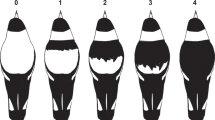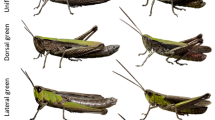Summary
Feral pigeons probably show greater variation in plumage colouration than any other free-living bird species. The different colour patterns are linked to ethological and physiological characteristics which in turn show different fitness under different urban selection pressures. The majority of the colouration types diverging from the wild type may be attributed to the domestic ancestors of our feral pigeons. Additionally, spontaneous mutations may occur as shown for the Vienna population. So far, rare colouration types have often been ignored, confounded or not correctly determined. In this paper, we consider all colouration types found in the feral pigeons of Basle and Vienna. We also list and compare the different corresponding hereditary factors.
Two samples (n1=153, n2=174) were taken of the feral pigeon population of Basle and compared with a sample of 7682 birds in Vienna (3.6%, 3.5% of the estimated populations). In total, there are 60 hereditary factors influencing the plumage colouration inColumba livia. Of these, 23 were found in Vienna and 13 in Basle. One bird of the Vienna population showed a hitherto unknown hereditary factor (rusty, ry). The hereditary factors resulted in 100 combinations in Vienna and 30 in Basle. There were significant differences in plumage colouration between the birds in the two study sites. In Basle, the dominant pigmentation Dominant Red (BA) was found nearly twice as often as in Vienna (9.2% vs 4.8%, χ2=13.1, p=0.0015). Significant difference emerged neither in the distribution of the primary patterns nor in the groups of Blue-bars (“Wild”), Melanics (“Urban”) and Others (“Domestics”). There were, however, significant differences in the additional factors (χ2=27.9, p=0.0058). The factor Pied appeared more frequently in Basle (G2=8.924, p=0.0028). This could be explained by the presence of a higher proportion of escaped carrier-pigeons. The factor Grizzle occurred more frequently in Vienna (G2=11.975, p=0.0005) owing to the influence of escaped tumblers. The different selection systems in Vienna and Basle are discussed with regard to their influence on the distribution of the plumage polymorphism.
Zusammenfassung
Straßentauben zeigen in ihrer Gefiederfärbung die wohl größte bekannte Variabilität unter den frei lebenden Vögeln. Der größte Teil der von der Wildform abweichenden Gefiederfärbungen läßt sich auf die Haustaubenvorfahren unserer Straßentauben zurückführen. Von den 60 bekannten und 52 in Mitteleuropa bei Straßentauben möglichen Erbfaktoren traten bei Wiener Straßentauben 23 in 100 Erbfaktorenkombinationen und bei Basler Straßentauben 15 in 30 Kombinationen auf. Für die größere Zahl an Erbfaktoren und Erbfaktorenkombinationen in Wien könnte die absolute Größe der Bestände, das unterschiedliche rezente Einfließen an Haustaubengenen in Wien und Basel sowie die relativ kleine Stichprobe in Basel verantwortlich sein. In Basel traten signifikant mehr Tiere mit der Grundfarbe Dominant Rot auf als in Wien. Dazu werden verschiedene Erklärungen diskutiert. In der Verteilung der Zeichnungsanlagen und der Gruppen der Blaubindigen, Melanisierten und Anderen traten zwischen Wien und Basel keine signifikanten Unterschiede auf. In der Verteilung der Zusatzfaktoren hingegen unterscheiden sich die beiden Populationen signifikant voneinander. Der in Basel häufigere Scheckfaktor könnte auf einen stärkeren Brieftaubeneinfluß, der in Wien häufigere Schimmelfaktor auf entflohene Tümmler zurückgehen. Die unterschiedlichen Selektionsregimes in Wien und Basel, vor allem der Feinddruck und die Ernährungssituation, werden in ihren möglichen Auswirkungen auf die Verteilung der Gefiederfärbungen diskutiert.
Similar content being viewed by others
Literatur
Burley, N. (1977): Parental investment, mate choice, and mate quality. Proc. Natl. Acad. Sci. USA 74: 3476–3479.
Burley, N. (1981): Mate choice by multiple criteria in a monogamous species. Am. Nat. 117: 515–528.
Clayton, D.H. (1990): Mate choice in experimentally parasitized rock doves: Lousy males lose. Amer. Zool. 30: 251–262.
Darwin, C. (1859): Die Entstehung der Arten durch natürliche Zuchtwahl oder die Erhaltung der bevorzugten Rassen im Kampfe ums Dasein. Leipzig.
Dunmore, R. (1968): Plumage polymorphism in a feral population of the rock pigeon. Amer. Midland Nat. 79/80: 1–7.
Gibson, L. P. (1993): Genetics of pigeonsColumba livia (Gmelin). Plain City.
Go, R. C.-P. (1972): The genetics of pigeon populations on Oahu. University of Hawaii, Ph. D., Biology-Genetics.
Goodwin, D. (1954): Notes on feral pigeons. Avic. Mag. 60: 190–213.
Goodwin, D. (1957): The colouration of feral pigeons in London. Bull. Brit. Orn. 77: 78–82.
Grüll, A. (1980):Columba livia Gmelin 1789-Straßentaube. In: Glutz von Blotzheim, U.N. & Bauer, K. M. (Hrsg.): Handbuch der Vögel Mitteleuropas, Band 9: 98–137. Wiesbaden.
Haag, D. (1984): Ein Beitrag zur Ökologie der Stadttaube. Diss. Phil. Nat. Fak. Universität Basel, Basel.
Haag, D. (1993): Street Pigeons in Basel. Nature 361: 200.
Haag-Wackernagel, D. (1995): Regulation of the street pigeon in Basel. Wildl. Soc. B. 23: 256–260.
Haag-Wackernagel, D. (1997): Die soziokulturellen Ursachen des Taubenproblems. Dtsch. Tierärztl. Wschr. 2: 52–57.
Haag-Wackernagel, D. (1998): Die Taube. Vom heiligen Vogel der Liebesgöttin zur Straßentaube. Basel.
Haag-Wackernagel, D. (1999): Ecology of feral pigeons in Basel, Switzerland. In: Farina, A., Kennedy, J. & Bossù, V. (Eds.) Procs. VII. Int. Congr. of Ecology, Florence 19–25 July 98 (in print).
Havelka, P. & Sabo, S. (1995): Mit Stadttauben leben. Landesanstalt für Umweltschutz, Arbeitsblätter zum Naturschutz 18.
Hollander, W.F. (1983): Origins and excursions in pigeon genetics. Burrton, Kansas.
Janiga, M., Mankovska, B., Bobal'ova, M., & Durcova G. (1990): Significance of concentrations of lead, cadmium, and iron in the plumage of the feral pigeon. Arch. Environ. Contam. Toxicol. 19: 892–897.
Janiga, M. (1991): Colour polymorphism in feral pigeons (Columba livia Gm. 1789). Acta F. R. N. Univ. Comen., Zool. 34: 31–37.
Janiga, M. (1996): Variation in size and shape of eggs of the feral pigeon (Columba livia). Folia Zool. 45(4): 301–310.
Johnston, R.F., Siegel-Causey, D. & Johnson, S. (1988): European populations of the rock doveColumba livia and genotypic extinction. Am. Midl. Nat. 120: 1–10.
Johnston, R.F. & Johnson, S.G. (1989): Nonrandom mating in feral pigeons. Condor 9: 23–29.
Johnston, R.F. & Janiga, M. (1995): Feral pigeons. Oxford.
Klemp, S. (1993): Die Stadttaube (Columba livia forma domestica) in Hamburg. Hamburger avifaun. Beitr. 24: 7–36.
Klemp, S. (1996): Unterschiede in der Brutaktivität einzelner Färbungsvarianten der Stadttauben (Columba livia forma domestica). Ökologie der Vögel (Ecol. Birds) 18: 77–84.
Leiss, A. (1998): „Rusty“-eine neue Farbmutation. Geflügel-Börse 16: 10–11.
Murton, R.K., Coombs, C.F.B. & Thearle, R.J.P. (1972): Ecological studies of the feral pigeonColumba livia var. II. Flock behaviour and social organisation. J. appl. Ecol. 9: 875–889.
Murton, R.K., Westwood, N.J. & Thearle, R.J.P. (1973): Polymorphism and the evolution of a continuous breeding season in the pigeon,Columba livia. J. Reprod. Fertil., Suppl. 19: 563–577.
Peterson, N.F. & Williamson, K. (1949): Polymorphism and breeding of the rock dove in the Faroe Islands. Ibis 91: 17–23.
Scherdlin, P. (1913): Über die Abnahme der verwilderten Haustauben am Straßburger Münster (Das Resultat einer Umfrage). Colmar.
Sell, A. (1986): Handbuch der Tauben, Band 1, Zucht und Vererbung bei Tauben. Hengersberg.
Steiner, R. & Zahner, A. (1994): Untersuchungen zur Siedlungsdichte und Aktionsradius der Straßentauben (Columba livia f. domestica) in Wien mit einer Bestandsschätzung für das gesamte Stadtgebiet. Egretta 37: 78–93.
Vater, G. (1998): Wie viele Tauben gibt es in mitteleuropäischen Städten? Der praktische Schädlingsbekämpfer 50: 12–17.
Vogel, C. & M., Bohne, J., Gerlach, H. & Greiner, A. (1994): Vergleichende Untersuchung zur Ausbleiber-Zuflieger-Problematik von Brieftauben in einer deutschen Reisevereinigung. In: Kösters J. (Hrsg.): IX. DVG-Tagung Vogelkrankheiten, 10–13.
Warriner, C.C., Lemmon, W.B. & Ray, T.S. (1963): Early experience as a variable in mate selection. Anim. Beh. II: 221–224.
Author information
Authors and Affiliations
Rights and permissions
About this article
Cite this article
Leiss, A., Haag-Wackernagel, D. Gefiederfärbungen bei der Straßentaube (Columba livia). J Ornithol 140, 341–353 (1999). https://doi.org/10.1007/BF01651031
Accepted:
Published:
Issue Date:
DOI: https://doi.org/10.1007/BF01651031




